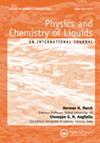赖克哈特染料溶剂极性和亚伯拉罕溶剂参数:检验相关性和预测建模
IF 1.1
4区 化学
Q4 CHEMISTRY, PHYSICAL
引用次数: 1
摘要
在各种科学应用中,“溶剂极性”的概念被广泛用于解释使用不同溶剂的影响。然而,对其定义和定量测量仍缺乏共识,阻碍了溶剂型研究的进展。本研究希望通过介绍溶剂极性的两种线性回归模型的发展来增加对话,基于Reichardt的ET(30)溶剂极性量表,使用Abraham溶剂参数和基于变压器的模型,直接从分子结构预测溶剂极性。第一个线性模型结合了标准Abraham溶剂描述符s、a、b和扩展模型离子描述符j+和j−,获得了令人印象深刻的测试集统计量R2 = 0.940(决定系数),MAE = 0.037(平均绝对误差),RMSE = 0.050(均方根误差)。第二个模型覆盖了更广泛的化学空间,但只使用了描述符s, a和b,得到了R2 = 0.842, MAE = 0.085, RMSE = 0.104的测试集统计量。基于变压器的模型适用于任何具有相关SMILES字符串的溶剂,其测试集统计量为R2 = 0.824, MAE = 0.066, RMSE = 0.095。我们的发现强调了亚伯拉罕溶剂参数,特别是双极性/极化性、氢键酸度/碱度和离子描述符在预测溶剂极性方面的重要性。这些模型为对Reichardt的ET(30)溶剂极性参数和溶剂极性一般感兴趣的研究人员提供了有价值的见解。本文章由计算机程序翻译,如有差异,请以英文原文为准。
Reichardt’s Dye-Based Solvent Polarity and Abraham Solvent Parameters: Examining Correlations and Predictive Modeling
The concept of “solvent polarity” is widely used to explain the effects of using different solvents in various scientific applications. However, a consensus regarding its definition and quantitative measure is still lacking, hindering progress in solvent-based research. This study hopes to add to the conversation by presenting the development of two linear regression models for solvent polarity, based on Reichardt’s ET(30) solvent polarity scale, using Abraham solvent parameters and a transformer-based model for predicting solvent polarity directly from molecular structure. The first linear model incorporates the standard Abraham solvent descriptors s, a, b, and the extended model ionic descriptors j+ and j−, achieving impressive test-set statistics of R2 = 0.940 (coefficient of determination), MAE = 0.037 (mean absolute error), and RMSE = 0.050 (Root-Mean-Square Error). The second model, covering a more extensive chemical space but only using the descriptors s, a, and b, achieves test-set statistics of R2 = 0.842, MAE = 0.085, and RMSE = 0.104. The transformer-based model, applicable to any solvent with an associated SMILES string, achieves test-set statistics of R2 = 0.824, MAE = 0.066, and RMSE = 0.095. Our findings highlight the significance of Abraham solvent parameters, especially the dipolarity/polarizability, hydrogen-bond acidity/basicity, and ionic descriptors, in predicting solvent polarity. These models offer valuable insights for researchers interested in Reichardt’s ET(30) solvent polarity parameter and solvent polarity in general.
求助全文
通过发布文献求助,成功后即可免费获取论文全文。
去求助
来源期刊

Physics and Chemistry of Liquids
化学-物理:凝聚态物理
CiteScore
3.30
自引率
8.30%
发文量
43
审稿时长
6-12 weeks
期刊介绍:
Physics and Chemistry of Liquids publishes experimental and theoretical papers, letters and reviews aimed at furthering the understanding of the liquid state. The coverage embraces the whole spectrum of liquids, from simple monatomic liquids and their mixtures, through charged liquids (e.g. ionic melts, liquid metals and their alloys, ions in aqueous solution, and metal-electrolyte systems) to molecular liquids of all kinds. It also covers quantum fluids and superfluids, such as Fermi and non-Fermi liquids, superconductors, Bose-Einstein condensates, correlated electron or spin assemblies.
By publishing papers on physical aspects of the liquid state as well as those with a mainly chemical focus, Physics and Chemistry of Liquids provides a medium for the publication of interdisciplinary papers on liquids serving its broad international readership of physicists and chemists.
 求助内容:
求助内容: 应助结果提醒方式:
应助结果提醒方式:


